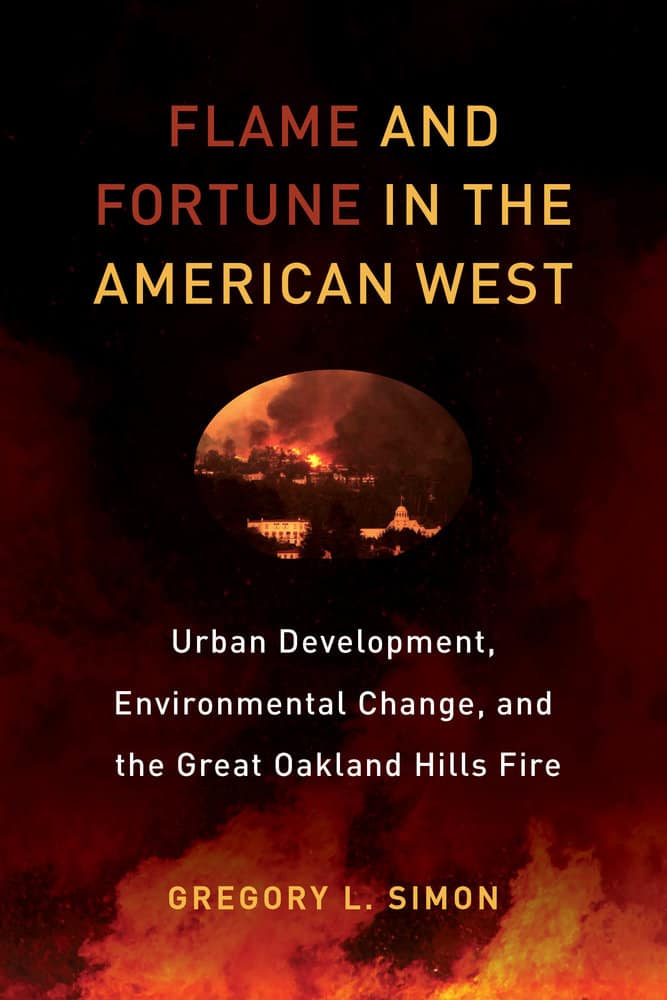by Gregory L. Simon, author of Flame and Fortune in the American West: Urban Development, Environmental Change, and the Great Oakland Hills Fire
Another day, another menacing wildfire. This appears to be the new fire regime for much of the American West. These days it is not uncommon to learn of several fire events each week – many of which threaten human settlements and force the evacuation of hundreds at the urban fringe. Meanwhile, tens of millions of dollars are spent fighting dangerous fires each month – an ever-expanding budget that reached nearly one billion in California alone during the 2016 fiscal year.
One reason for this massive budget allocation is that – thanks to climate change – the West is now hotter and drier than at anytime in recent memory. And yet, our changing climate only touches the surface of the problem. Much more important when explaining increasingly costly and injurious wildfires are the millions of homes we place in harms way. It is the expansion of urban settlements into undeveloped areas that have turned historically active fire regimes into a string of deadly and costly wildfire events. Indeed, there is nothing inherently disastrous about fire itself – we are the ones adding fuel (and risk) to the fire.
Out of this hazardous context one wildfire rises above the rest: the 1991 Oakland Hills Firestorm, which remains the largest and most intense wildfire in California’s history in terms of total structures burned. To be sure, this is a dubious – if startling – distinction given the state’s long history of devastating wildfires. The superlatives go on. With over 3000 units seared in only 1500 acres, the level of damage per acre produced by the Oakland Hills Fire is simply unmatched in modern US history.
With the 25th Anniversary of the 1991 Oakland Hills Fire upon us we are reminded that this area was once a distant suburb to the fast-growing city of San Francisco. Its development over many decades therefore holds similarities to other areas witnessing ongoing suburban sprawl around the west. Across the region 38% of urban growth is occurring at the city’s edge. But perhaps more disconcerting is that only 14% of privately held land has been developed to date. This means there is still considerable room for more sprawl – and the creation of still further fire risks and costs across the region. To be sure, this is a deeply troubling state of affairs.
Flame and Fortune in the American West: Urban Development, Environmental Change and The Great Oakland Hills Fire investigates the politics, folly, and avarice shaping the production of these increasingly widespread yet dangerous suburban landscapes. Using the Oakland Hills Fire as a principal case study Flame and Fortune argues that suburban landscapes are lucrative landscapes. They are areas that generate revenue and wealth for interested parties near and far – from profitable land use extraction activities to increased tax revenues and elevated real estate values.
Over time the generation of these financial benefits has coincided with the production of immense costs and social risks. Unfortunately, popular and media reporting on wildfires tend to underplay the role of these powerful urban growth incentives. Instead, news reports have become fixated almost entirely on climate change as the driving force behind wildfire disasters. As a consequence, public agencies are left tinkering around the edge of the problem, constantly putting out little fires instead of grappling with the social root cause of the major blaze itself.
___
I was a teenager home alone at the time of the Oakland Hills Firestorm. Twenty-five years later, I can vividly recall fleeing alongside red embers as they whipped and bounced down the road past me. I also remember returning days later to scan cinereous slopes and valleys, full of protruding chimneys stripped bare in all directions. These and other similar images are seared into the memories of far too many. It is my hope that Flame and Fortune provides the reader with a provocative and engaging reading experience while raising awareness about this notorious fire.
More fundamentally, I hope this book and the 25th anniversary of the Great Oakland Hills Fire spark a renewed conversation between civil society and government decision makers alike about reducing fire costs, risks and losses in the future. As the final sentence of Flame and Fortune suggests, “the path forward will certainly not be easy to conceive or attain, but this does not mean we should treat the road ahead as inconceivable or unattainable.”


